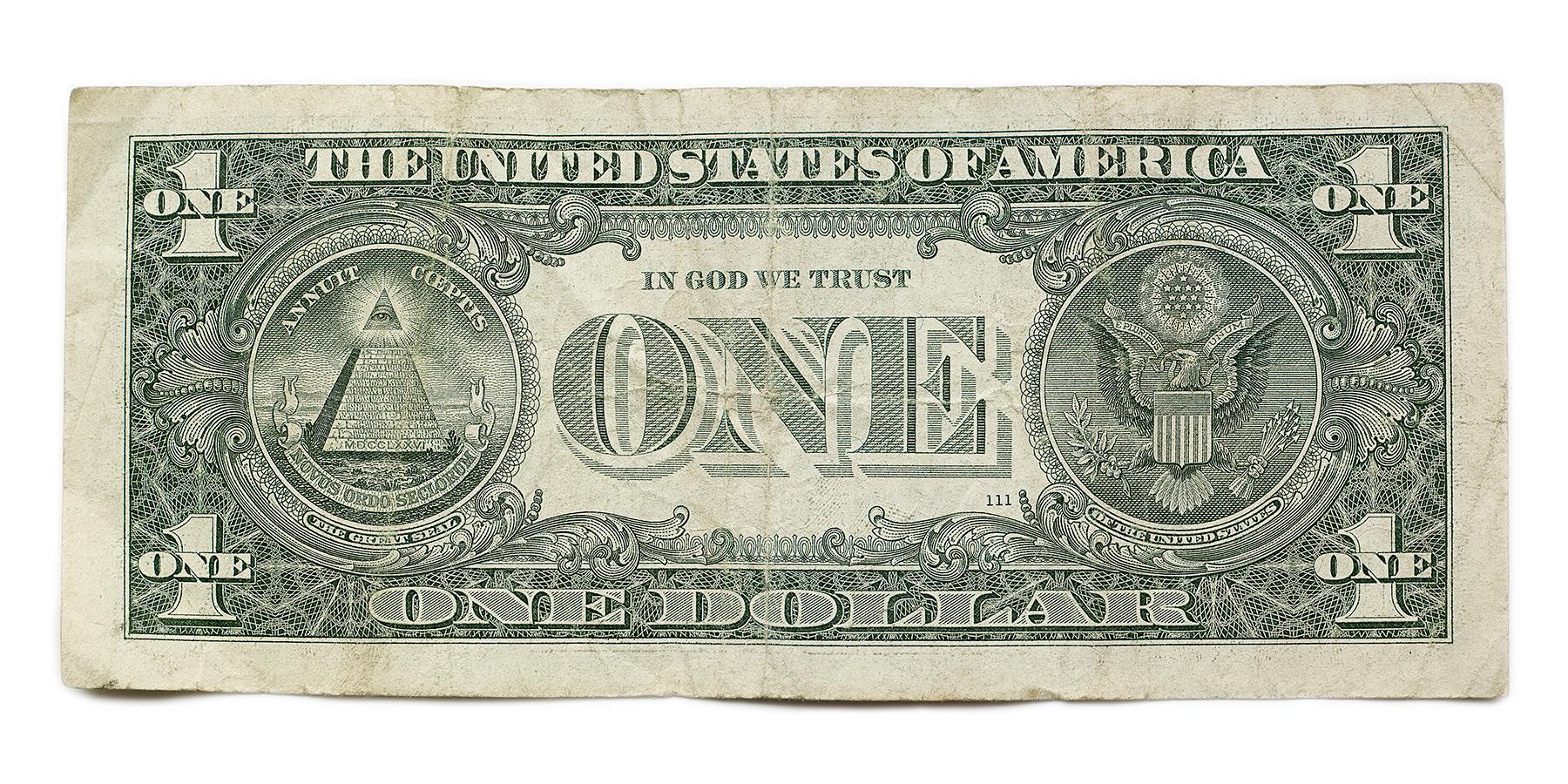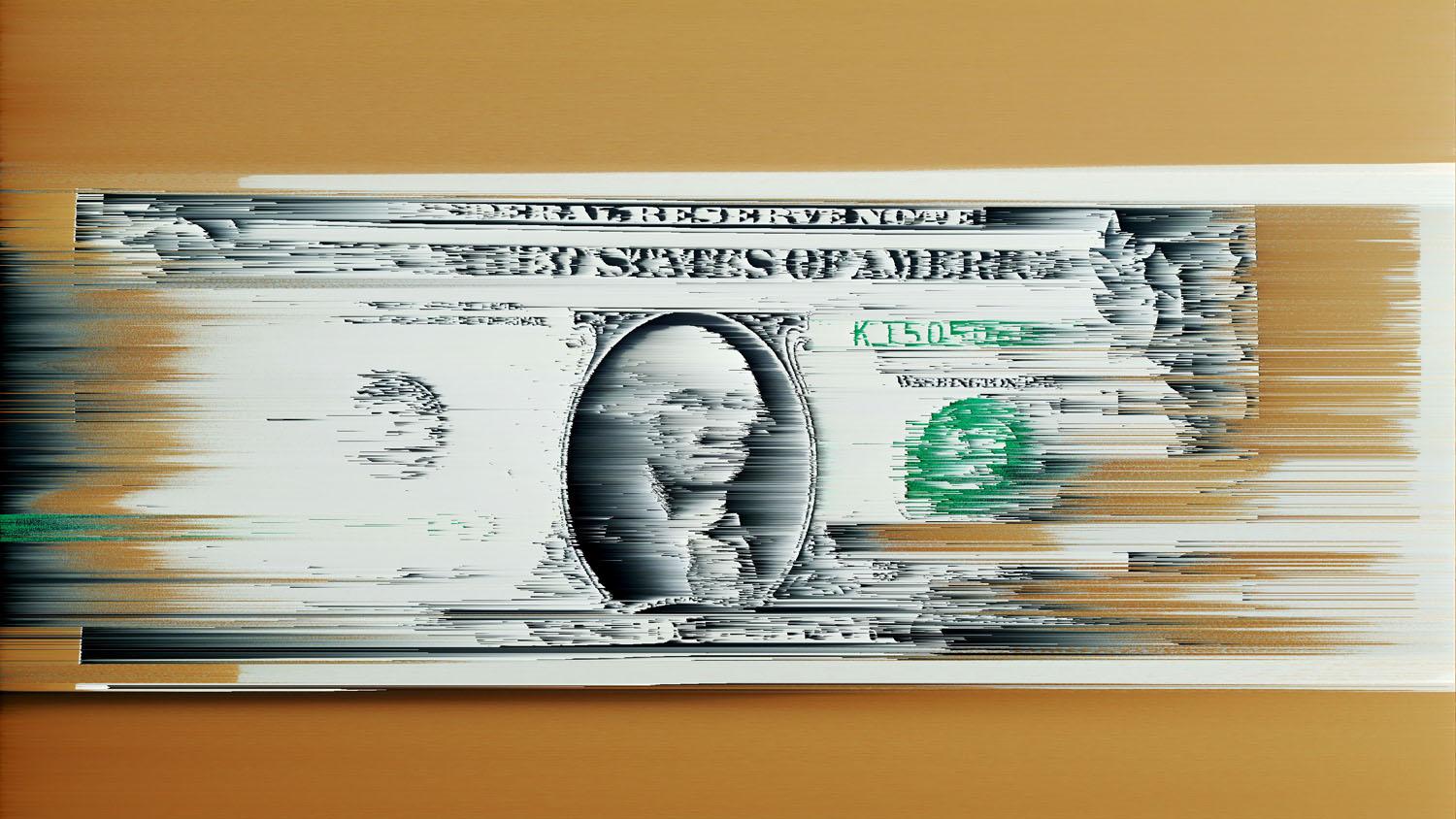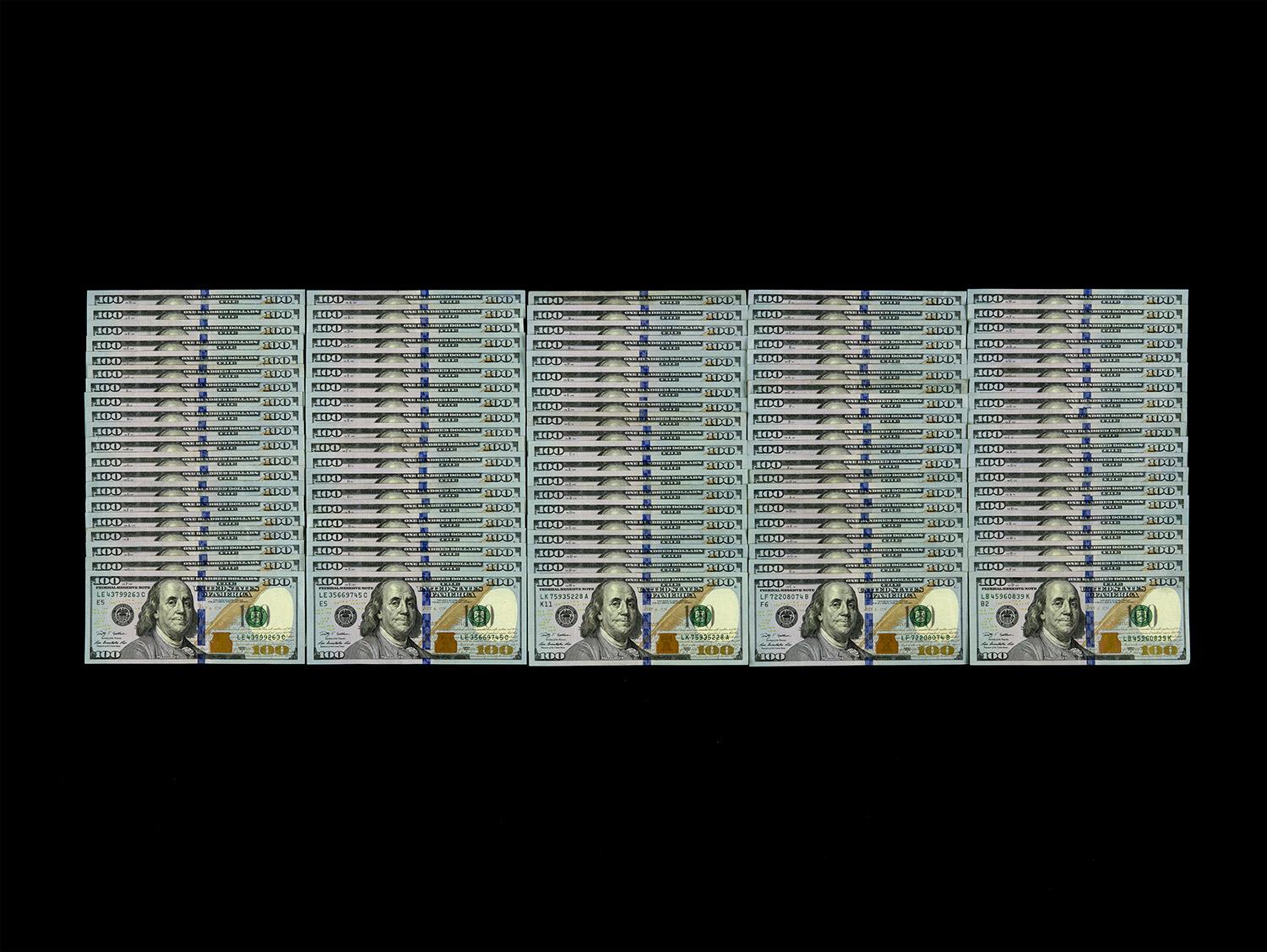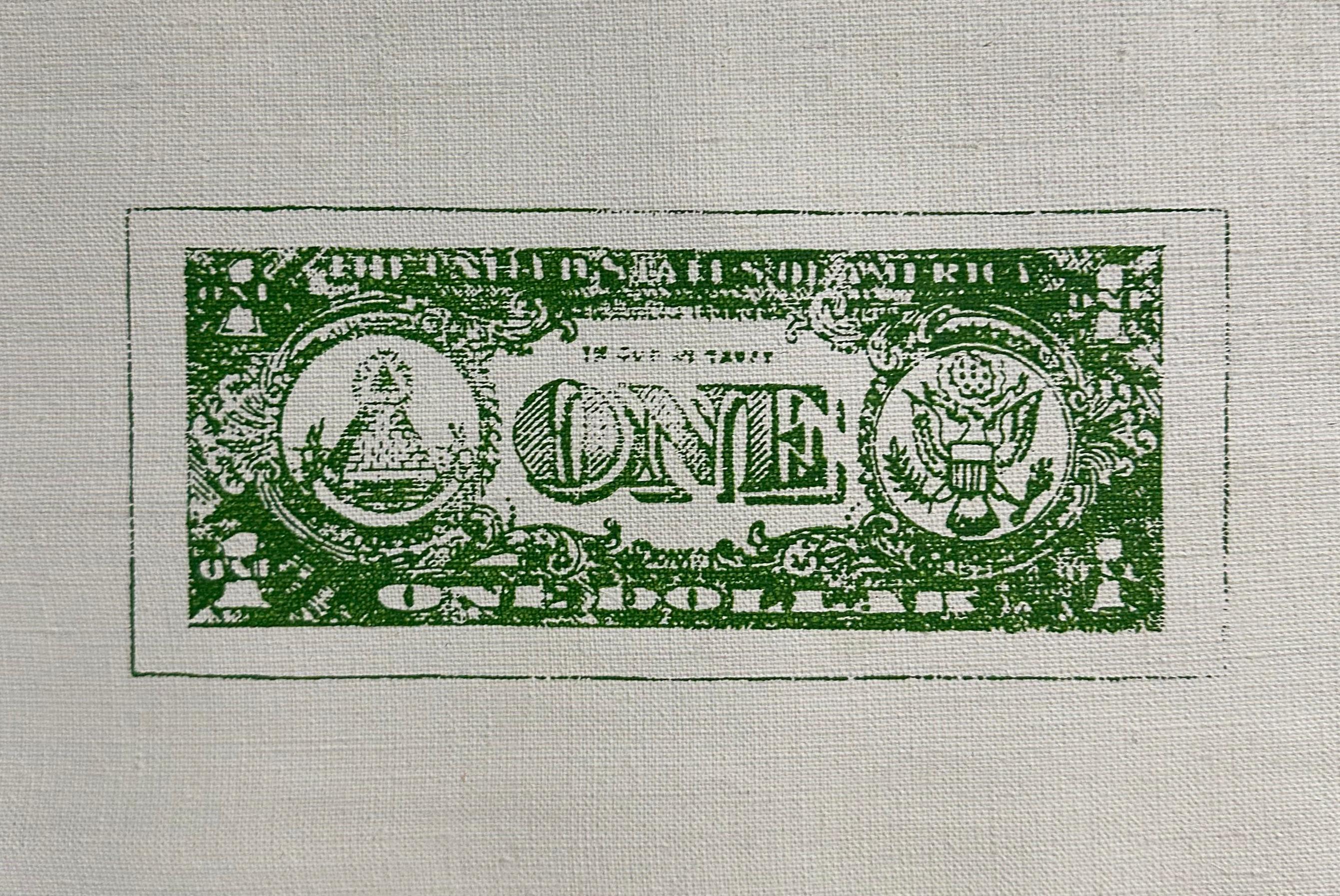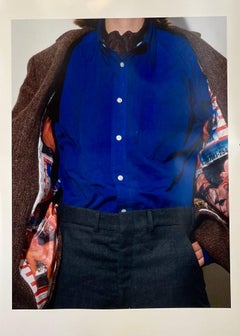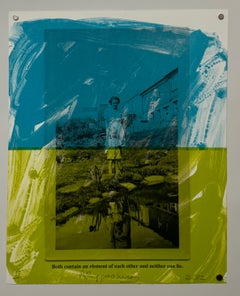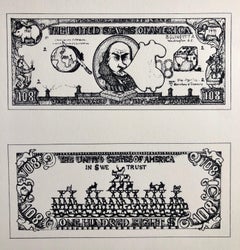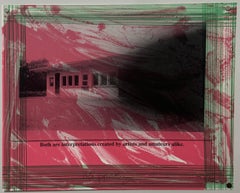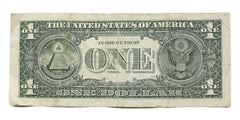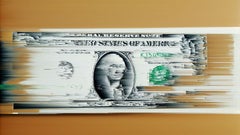Items Similar to Meschac Gaba Inkjet Pigment Print Photograph African Conceptual Art Dollar Bill
Want more images or videos?
Request additional images or videos from the seller
1 of 16
Meschac GabaMeschac Gaba Inkjet Pigment Print Photograph African Conceptual Art Dollar Bill2004-2005
2004-2005
$3,000
£2,264.02
€2,591.96
CA$4,230.99
A$4,645.10
CHF 2,423.36
MX$56,212.23
NOK 30,373.07
SEK 28,619.42
DKK 19,348.27
About the Item
Meschac Gaba (Benin, 1961- )
Artist with American Inspiration: 4 World Financial Center, 2004, Meschac Gaba, pigmented inkjet print,
Hand signed, dated and inscribed '15 des 30 Artiste d'inspiration Americaine' verso.
Dimensions: approximately 17 1/2 x 42 1/2 in. (sheet), 19 x 44 in. (frame)
Meshac Gaba employs an intervention on an American dollar bill in Artist with American Inspiration: 4 World Financial Center, swapping out our stately eagle for his smiling face portrait. One of Gaba’s sculptures appears on the left as well.
Meschac Gaba (born 1961) is a Beninese conceptual artist based in Rotterdam and Cotonou. His installations of everyday objects whimsically juxtapose African and Western cultural identities and commerce. He is best known for The Museum of Contemporary African Art 1997–2002, an autobiographical 12-room installation acquired and displayed by the Tate Modern in 2013. He has also exhibited at the Studio Museum in Harlem and at the 2003 Venice Biennale.
Meshac Gaba was born in Cotonou, Benin, in 1961. He had drifted from his training as a painter until a bag of decommissioned money cut into confetti led him to make paintings with the material. 1981-1985 He was a student at the artist studio of Zossou Gratien, Cotonou, Benin.
Gaba became known for his installations of everyday objects that whimsically juxtapose African and Western cultural identities and commerce.
He held a residency at the Amsterdam Rijksakademie in 1996 for two years. In the absence of opportunities to display his work in the city, he set out over the next five years to make his own museum. This piece became his seminal The Museum of Contemporary African Art 1997–2002, which consists of 12 rooms (some based on museum function and others personal) filled with objects made by Gaba. Throughout the exhibition ran a vein of confessional narrative about the artist's art travails between Africa and Europe The wedding room, which he made while in love, holds mementos as museum artifacts from Gaba's wedding to the Dutch curator Alexandra van Dongen in 2000 at the Amsterdam Stedelijk Museum. The Library room holds art books and tells of Gaba's childhood.The games room showed sliding puzzle tables that form African national flags. It had its own gift shop and café. The exhibited Museum had couches for reading, a piano for playing, and featured objects reflecting Africa's polycultural character, including Ghanaian money featuring the face of Pablo Picasso, a Swiss bank mimicking an African street market, and gilded ceramic chicken legs.
The Museum exhibited widely. The work was first displayed in part in 2002 at Documenta 11. Gaba received a Rotterdam space in which he could live and store the work. When his son requested a more normal house, Gaba sold and gifted most of the work to the Tate Modern, save for his Library, which Gaba returned to his hometown. Around 2013, Gaba lived half the year in his hometown of Cotonou and the other half in Rotterdam with his wife and son. The Tate Modern displayed the work as a whole in 2014 as part of the Tate's two-year program of African-focused exhibitions. The wedding room enchanted the British art critic Jonathan Jones, who described the Museum as autobiographical, novelistic, protest showing "the strength of modern African art". For instance, the Art and Religion room showed "classic" African ceremonial sculpture alongside kitschy Buddhist and Christian objects, as if to group the types together as poor representations of their respective cultures. Gaba saw the work as correcting lacks of art education in Africa and African art representation outside the continent.
In-between finishing the Museum and its Tate exhibition, Gaba presented at the 2003 Venice Biennale and held his first solo show in the United States at the Studio Museum in Harlem, "Tresses", a series of architectural models of New York City and Benin landmarks made from artificial braided hair extensions. The accessory, popularized by African-American pop stars based on West African culture, was repatriated to Africa. Gaba worked with a Beninese hair braider to make the sculptures from his photographs. Holland Cotter wrote in The New York Times that the works were "delightful" and recognizable without becoming caricatures.
Gaba held his first solo gallery show, "Exchange Market", in New York in 2014. On the ground floor, 10 sculptures of unvarnished wood tables each with a wire umbrella stand, from which African banknotes hung. Each table was associated with a type of commodity: cotton, cocoa, diamonds. Along the walls hung bank-shaped works made of wood, plexiglass, and decommissioned money. Upstairs, reminiscent of the games room of Gaba's museum, were four foosball tables and small souvenir sculptures such as hand-painted cricket bats and a miniature billiards table.
Artsy selected Gaba's work as a highlight of the 2014 1:54 London art fair.
Selected exhibitions
"Exchange Market", Tanya Bonakdar Gallery, New York City,
"Museum of Contemporary African Art", Tate Modern,
"Tresses", Studio Museum in Harlem
2023 Imaginary Friends, Joan Miro Foundation, Barcelona, Spain (Paola Pivi, Kasper Bosmans, Polly Apfelbaum, Meschac Gaba, Afra Eisma, Pipilotti Rist and Martin Creed)
2019 Leaving the Echo Chamber, Making New Time, 14th Sharjah Biennial,
How the light gets in: migration in contemporary art, Herbert F. Johnson Museum of Art (Radcliffe Bailey, Dawoud Bey, Enrique Chagoya, Meschac Gaba, Mona Hatoum,Zoe Leonard, Glenn Ligon, Catherine Opie, Yinka Shonibare, and Ai Weiwei plus more)
The Studio Museum in Harlem: Black Refractions: Highlights from The Studio (Derrick Adams, Njideka Akunyili Crosby, Benny Andrews, Romare Bearden, Mark Bradford, Beauford Delaney, Thornton Dial, Sam Gilliam, Lyle Ashton Harris, Loïs Mailou Jones,Kerry James Marshall, Chris Ofili, Faith Ringgold, Betye Saar, Lorna Simpson, Carrie Mae Weems, and Kehinde Wiley etc.)
Museum in Harlem, Kalamazoo Institute of Arts, MI,
Museum of Contemporary African Art (selections), Works
Tate Switch House, London
The Warmth of Other Suns, The Phillips Collection,
The Harry David Art Collection, focusing on artists engaging with cultural, political and historical voices that reflect the continent of Africa. The collection includes works by Beninese artist Meschac Gaba, Kenya-born artist Wangechi Mutu, South African/Malawian artist Billie Zangewa, the Nigerian Taiye Idahor, the African-Americans Hank Willis Thomas, Mickalene Thomas and Rashid Johnson, as well as the British artists Chris Ofili and Lynette Yiadom-Boakye.
Fernet Branca Foundation, Saint-Louis, France
Enchanted Bodies / Fetish for Freedom, curated by Bernardo Mosqueira,
Galleria d'Arte Moderna e Contemporanea di Bergamo,
The Red Hour, 13th edition of the Biennial of Contemporary African Art,
DAK'ART, Dakar, Senegal
2015 Making Africa, A Continent of Contemporary Design, Guggenheim Bilbao, Bilbao, Spain
Making Africa: A Continent of Contemporary Design, Vitra Design Museum, Weil am Rhein, Germany
Casino, Le Pavé Dans La Mare, Besançon, France
Musée des Arts d'Afrique et d'Océanie curated by Fede Benet, Paris
- Creator:Meschac Gaba (1961)
- Creation Year:2004-2005
- Dimensions:Height: 19 in (48.26 cm)Width: 44 in (111.76 cm)
- Medium:
- Movement & Style:
- Period:
- Condition:piece is well protected. frame has wear and can use a paint job.
- Gallery Location:Surfside, FL
- Reference Number:1stDibs: LU38212448552
About the Seller
4.9
Platinum Seller
Premium sellers with a 4.7+ rating and 24-hour response times
Established in 1995
1stDibs seller since 2014
1,810 sales on 1stDibs
Typical response time: 1 hour
- ShippingRetrieving quote...Shipping from: Surfside, FL
- Return Policy
Authenticity Guarantee
In the unlikely event there’s an issue with an item’s authenticity, contact us within 1 year for a full refund. DetailsMoney-Back Guarantee
If your item is not as described, is damaged in transit, or does not arrive, contact us within 7 days for a full refund. Details24-Hour Cancellation
You have a 24-hour grace period in which to reconsider your purchase, with no questions asked.Vetted Professional Sellers
Our world-class sellers must adhere to strict standards for service and quality, maintaining the integrity of our listings.Price-Match Guarantee
If you find that a seller listed the same item for a lower price elsewhere, we’ll match it.Trusted Global Delivery
Our best-in-class carrier network provides specialized shipping options worldwide, including custom delivery.More From This Seller
View AllAfrican American Large Vintage Color Photograph Dandy C Print Photo Ike Ude
By Iké Udé
Located in Surfside, FL
BEYOND DECORUM, CLOSED AND OPEN Series,
I am selling each individually. they are pairs of open and closed jackets. I will include the second photo for reference. This listing is just for the open jacket photograph.
Vintage C-print on Fuji crystal archive paper.
Image size is 40 x 30", sheet measures 50 X 35
Provenance: printed by Muse X, Los Angeles.
I believe these were test, proof prints. They are not signed or editioned
The work of Nigerian-born Iké Udé explores a world of dualities: photographer/performance artist, artist/spectator, African/post-nationalist, mainstream/marginal, individual/everyman and fashion/art.
Iké Udé (born 1964) is a Nigerian-American photographer, performance artist,
Ike Ude was born in 1964 in Lagos, Nigeria where he was raised. The eldest son of a wealthy family, he was exposed to photography and portraiture at an early age by dressing up for biweekly family portraits. Udé knew he was an artist by the age of six, when he developed a habit of firing a catapult at passers-by when he disapproved of their walk or the way they were dressed. As an adolescent, Udé attended the Government Secondary School, a British boarding school in Afikpo Nigeria. He was a habitué of London before he moved to New York in 1981 to study Media Communications at Hunter College, CUNY. He began his art career in the late 1980s with abstract painting and drawing. Since the 1990s, photography has been his primary medium. Udé is a dual citizen of the United States and Nigeria.
Udé's paintings and drawings are less well known than his photography, though critics and art historians have recognized his early work. The late Henry Geldzahler, said of Udé's paintings and works on paper: "I am touched and amazed at the ways in which he manages to blend invisibly the modernist tradition with his own Nigerian roots. There is never anything forced in the conjunction; air and light seem to be his media."
Udé began his Cover Girls series in 1994. Each photograph imitates the cover of a popular fashion or lifestyle magazines, in which the artist himself is featured as the model. (ala the work of Cindy Sherman) The photographs were consciously stylized, posed, photographed and then paired with type matching that of the respected magazine. At first glance, each photograph appears to be an authentic magazine cover. Udé used the magazine cover as a stage to critique the fetishism of the upper class white model and the effects of popular culture on today's consumerist society. The series was exhibited in 1994 in the New York City gallery Exit Art.
Udé's black and white series of photographs, Uli, references both high fashion and Uli body art, wall motifs from Udé's Igbo heritage. The photographs explore the anonymity of the inscribed and disembodied self. Udé's dynamic use of light, namely the chiaroscuro effect, serves as a critical compositional element in the series.
Udé's Beyond Decorum series, begun in 1999, juxtaposes photographs of men's shirts and women's pumps with suggestive personal advertisements in place of the clothing tags.
With its accompanying book, Beyond Decorum: Photographs by Iké Udé, the series traveled across the United States and Canada. The exhibition was shown at the Institute of Contemporary Art in Portland, Maine; OBORO in Montreal, Canada; Sert Gallery; Carpenter Center at the Harvard University Art Museum; and MAK Museum in Vienna, Austria before traveling for two more years internationally.
Udé's Paris Hilton: Fantasy and Simulacrum is a conversation between his alter ego, Visconti, and the celebrity Paris...
Category
1990s Conceptual Color Photography
Materials
Photographic Paper, C Print, Color
Conceptual Artist Allen Ruppersberg Hand Printed Lithograph Prints & Photographs
By Allen Ruppersberg
Located in Surfside, FL
Allen Ruppersberg (American, 1944-)
Lithograph, Mixed media
From the Top Ten Historical Similarities (and Differences) Between Prints and Photographs.
This sale is of one print not t...
Category
2010s Conceptual Abstract Photography
Materials
Mixed Media, Lithograph
1960's Pop Art Silkscreen Print 108$ Bill Inflation Hand Signed and Numbered
By Oyvind Fahlstrom
Located in Surfside, FL
Öyvind Axel Christian Fahlström (1928–1976) was a Swedish Multimedia artist.
Fahlström was born in Sao Paulo, Brazil, In July 1939 he was sent to Stockholm to visit some distant relatives and after World War II he started to study and later on to work as a writer, critic and journalist. From 1960 until 1976 he was married to the Swedish Pop Art painter Barbro Östlihn.
In 1953 Fahlström had his first solo exhibition, showing the drawing Opera, a room-sized felt-pen drawing. Also in 1953 he wrote Hätila ragulpr på fåtskliaben, a manifesto for concrete poetry, published in Swedish the following year and in English translation (by Mary Ellen Solt, in her anthology "Concrete Poetry. A world view") in 1968.
In 1956 Fahlström moved to Paris and lived there for three years before he moved to Front Street studio, New York City. In New York he worked with different artists and explored his role as an artist further. In 1962 he participated in the New Realists exhibition at the Sidney Janis Gallery, in New York City. His work was included in the 1964 Venice Biennale and he had a solo exhibition at Cordier & Ekstrom Inc., New York. In 1965 he joined the Sidney Janis Gallery.
In 1966 his work Performance of Kisses Sweeter Than Wine was included in 9 Evenings: Theatre and Engineering, organized by Experiments in Art and Technology at the 26th Street Armory, New York. The same year his painting in oil on photo...
Category
1970s Pop Art Figurative Prints
Materials
Lithograph, Screen
Conceptual Artist Allen Ruppersberg Hand Printed Lithograph Prints & Photographs
By Allen Ruppersberg
Located in Surfside, FL
Allen Ruppersberg (American, 1944-)
Lithograph, Mixed media
From the Top Ten Historical Similarities (and Differences) Between Prints and Photographs.
This sale is of one print not t...
Category
2010s Conceptual Abstract Photography
Materials
Mixed Media, Lithograph
African American Large Vintage Color Photograph Dandy C Print Photo Ike Ude
By Iké Udé
Located in Surfside, FL
BEYOND DECORUM, CLOSED AND OPEN Series,
I am selling each individually. they are pairs of open and closed jackets. I will include the second photo for reference. This listing is just for the closed jacket photograph.
Vintage C-print on Fuji crystal archive paper.
Image size is 40 x 30", sheet measures 50 X 36
Provenance: printed by Muse X, Los Angeles.
I believe these were test, proof prints. They are not signed or editioned
The work of Nigerian-born Iké Udé explores a world of dualities: photographer/performance artist, artist/spectator, African/post-nationalist, mainstream/marginal, individual/everyman and fashion/art.
Iké Udé (born 1964) is a Nigerian-American photographer, performance artist,
Ike Ude was born in 1964 in Lagos, Nigeria where he was raised. The eldest son of a wealthy family, he was exposed to photography and portraiture at an early age by dressing up for biweekly family portraits. Udé knew he was an artist by the age of six, when he developed a habit of firing a catapult at passers-by when he disapproved of their walk or the way they were dressed. As an adolescent, Udé attended the Government Secondary School, a British boarding school in Afikpo Nigeria. He was a habitué of London before he moved to New York in 1981 to study Media Communications at Hunter College, CUNY. He began his art career in the late 1980s with abstract painting and drawing. Since the 1990s, photography has been his primary medium. Udé is a dual citizen of the United States and Nigeria.
Udé's paintings and drawings are less well known than his photography, though critics and art historians have recognized his early work. The late Henry Geldzahler, said of Udé's paintings and works on paper: "I am touched and amazed at the ways in which he manages to blend invisibly the modernist tradition with his own Nigerian roots. There is never anything forced in the conjunction; air and light seem to be his media."
Udé began his Cover Girls series in 1994. Each photograph imitates the cover of a popular fashion or lifestyle magazines, in which the artist himself is featured as the model. (ala the work of Cindy Sherman) The photographs were consciously stylized, posed, photographed and then paired with type matching that of the respected magazine. At first glance, each photograph appears to be an authentic magazine cover. Udé used the magazine cover as a stage to critique the fetishism of the upper class white model and the effects of popular culture on today's consumerist society. The series was exhibited in 1994 in the New York City gallery Exit Art.
Udé's black and white series of photographs, Uli, references both high fashion and Uli body art, wall motifs from Udé's Igbo heritage. The photographs explore the anonymity of the inscribed and disembodied self. Udé's dynamic use of light, namely the chiaroscuro effect, serves as a critical compositional element in the series.
Udé's Beyond Decorum series, begun in 1999, juxtaposes photographs of men's shirts and women's pumps with suggestive personal advertisements in place of the clothing tags.
With its accompanying book, Beyond Decorum: Photographs by Iké Udé, the series traveled across the United States and Canada. The exhibition was shown at the Institute of Contemporary Art in Portland, Maine; OBORO in Montreal, Canada; Sert Gallery; Carpenter Center at the Harvard University Art Museum; and MAK Museum in Vienna, Austria before traveling for two more years internationally.
Udé's Paris Hilton: Fantasy and Simulacrum is a conversation between his alter ego, Visconti, and the celebrity Paris...
Category
1990s Conceptual Color Photography
Materials
Photographic Paper, C Print, Color
Conceptual Artist Allen Ruppersberg Hand Printed Lithograph Prints & Photographs
By Allen Ruppersberg
Located in Surfside, FL
Allen Ruppersberg (American, 1944-)
Lithograph, Mixed media
From the Top Ten Historical Similarities (and Differences) Between Prints and Photographs.
This sale is of one print not t...
Category
2010s Conceptual Abstract Photography
Materials
Mixed Media, Lithograph
You May Also Like
Peter Andrew Lusztyk - One, Photography 2021, Printed After
By Peter Andrew Lusztyk
Located in Greenwich, CT
One
Digital C-Print / Archival Pigment Print
Edition of 1 per size
Available sizes:
36 x 72 in
48 x 96 in
“Collectible” series is a macro level exploration of coins, bills and stamp...
Category
2010s Contemporary Color Photography
Materials
Archival Pigment
US Dollar, Katie Hallam, Contemporary Art, Abstract Art, Financial Art, American
By Katie Hallam
Located in Deddington, GB
Katie Hallam Dollar Digital Photograph
The value of money is always going to be a topical discussion. ‘Dollar’ looks at the current climate of relationships, value and connections...
Category
2010s Contemporary Abstract Photography
Materials
Metal
Dollar, Digital Artwork, Limited Edition Pop Art Photograph on Aluminium
By Katie Hallam
Located in Deddington, GB
The value of money is always going to be a topical discussion. ‘Dollar’ looks at the current climate of relationships, value and connections within currency what some might say the s...
Category
2010s Contemporary Abstract Photography
Materials
Digital
One Dollar Bill, Photomosaic on Aluminum by Robert Silvers
By Robert Silvers
Located in Long Island City, NY
Artist: Robert Silvers, American (1968 - )
Title: One Dollar Bill
Year: 2010
Medium: Digital Photomosaic on Fuji Crystal Archive mounted on aluminum
Edition: 10
Size: 27 x 63 in. (68...
Category
2010s Pop Art Black and White Photography
Materials
Photographic Paper, Digital
Christos J. Palios - 10, 000 Cash, Photography 2016, Printed After
By Christos J. Palios
Located in Greenwich, CT
This photograph belongs to the series, "Absolute Powers / ex nihilo." These photographs dive deeper into the taboo and controversial topic of money by showcasing an array of intrigui...
Category
2010s Contemporary Still-life Photography
Materials
Archival Pigment
Denied Andy Warhol Dollar Bill Painting / Charles Lutz
By Charles Lutz
Located in Brooklyn, NY
Denied Andy Warhol Dollar Bill Painting / Charles Lutz
silkscreen ink on linen with the Denied stamp of the Andy Warhol Art Authentication Boar...
Category
Early 2000s Pop Art Portrait Paintings
Materials
Linen, Acrylic
